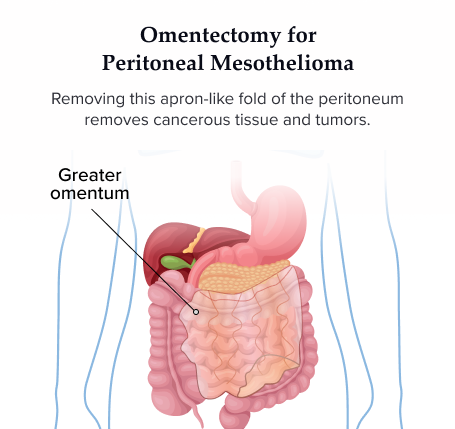Omentectomy for Mesothelioma
Peritoneal mesothelioma surgeons perform an omentectomy to remove tumors on the omentum. They often perform it during cytoreductive surgery with heated chemotherapy. This procedure improves chemotherapy outcomes and patient survival.

What Is an Omentectomy?
An omentectomy is a surgery doctors perform to remove tumors and treat peritoneal mesothelioma. During this procedure, surgeons remove part or all of the omentum, which is an apron-like fold of a thin tissue lining the belly that covers and protects organs like the stomach and intestines. This lining is called the peritoneum and it protects your abdominal organs like a soft, flexible blanket. It stores fat, helps with healing and supports the immune system.
When mesothelioma affects the lining of your abdomen, cancer cells can spread through the omentum. An omentectomy aims to remove as much of this cancerous tissue as possible. Doctors carefully plan this surgery to improve your outlook.
Key Facts About Omentectomy for Mesothelioma
- Omentectomy is a standard part of tumor removal or cytoreductive surgery for peritoneal mesothelioma.
- Surgeons often perform a total omentectomy to reduce the risk of leaving cancer cells behind after surgery.
- Heated chemo is often applied directly like a medicinal wash after tumor removing surgery in the abdomen.
- Removing the omentum allows the heated chemo to reach more of any remaining cancer cells.
This surgery for mesothelioma helps doctors remove cancerous tissue and give heated chemo, or HIPEC, a better chance of penetrating any remaining cancer cells. Doctors understand this is serious surgery, and they strive to give patients the best care possible.
“Performing a total omentectomy for HIPEC requires significant surgical skill and experience,” says mesothelioma expert Dr. Shanel Bhagwandin. He offers the procedure at Jupiter Medical Center where he leads the Gastrointestinal Surgical Oncology Program.
Types of Omentectomy
There are different types of omentectomy. Each removes different amounts or sections of the omentum. A total omentectomy is often preferred to treat peritoneal mesothelioma. The aim is to remove as much cancerous tissue as possible, reducing the risk of recurrence, with little risk to other organs.
A partial omentectomy may be initially appropriate in rare peritoneal mesothelioma cases known as unifocal. In unifocal cases, this cancer grows as a single tumor rather than many small nodules.
Different Kinds of Omentectomy Procedures
- Directed (sentinel) omentectomy: Surgeons remove specific, targeted parts of the omentum.
- Infracolic omentectomy: Surgeons remove the omentum below the colon.
- Partial omentectomy: Surgeons remove only a portion of the omentum.
- Selective omentectomy: Surgeons choose to remove only certain areas of the omentum.
- Total (supracolic) omentectomy: Surgeons remove the entire omentum.
Doctors may also perform a partial omentectomy to help diagnose peritoneal disease. Peritoneal mesothelioma survivor Trina Reif had an omentectomy as part of her diagnostic workup. Her doctor, OB/GYN, Dr. Anton Strocel, had been treating her for pelvic pain for years.
Strocel tells us, “She did well for a while. Some time later she presented to me with unexplained ascites (excess abdominal fluid). Subsequently we did an exploratory laparotomy and did an omentectomy, an appendectomy and multiple peritoneal biopsies for an angry looking peritoneum. The pathological diagnosis turned out to be abdominal mesothelioma.”
How Does an Omentectomy Treat Mesothelioma?

An omentectomy removes tumors on the omentum in order to treat peritoneal mesothelioma, which often spreads on this fatty tissue. Most advanced cases of this type of mesothelioma show tumors on the omentum.
The folded structure of the omentum creates pockets where chemo can’t reach. Removing it allows more uniform chemo distribution throughout the peritoneal cavity. This helps heated chemo to reach more tissue and cancer cells.
Removing the omentum can help slow down or even stop mesothelioma’s spread. This offers you a better chance of longer survival and improved quality of life. Doctors carefully weigh the benefits and risks of this surgery before recommending this mesothelioma treatment. An omentectomy also treats an extremely rare type of mesothelioma: primary omental mesothelioma. Only a few cases have ever been reported in medical literature.

Gain access to top mesothelioma doctors and get help scheduling appointments.
Connect NowWhat to Expect From an Omentectomy?
People with peritoneal mesothelioma can expect their omentectomy procedure to be a long surgery. It can take a while for surgeons to remove the omentum whether it’s done as a standalone procedure or as part of more aggressive surgery.
Recovery can also be a long process. It may take weeks or months depending upon the extent of the surgery.
Before, During and After an Omentectomy
- Doctors do tests before surgery to check your health.
- You’ll need to stop eating and drinking before the operation.
- Doctors give you medicine, so you’ll sleep during the surgery.
- The surgery can take several hours depending on your surgical plan.
- You’ll stay in the hospital for several days after surgery.
- Help at home during your recovery will be necessary.
- Doctors give you medicine to help with pain after surgery.
After surgery, focus on resting and following your doctor’s instructions. Slowly increase your activity level as you feel better. Eat healthy foods to help your body heal. Try to stay positive and ask your medical team any questions you may have.
Benefits of Omentectomy for Mesothelioma Patients
Removing tumors during an omenectomy can stop the cancer from spreading and reduce the risk of it returning, significantly benefiting people with peritoneal mesothelioma. People may feel better after they recover from surgery. It gives them a higher chance of a longer life.
Positive Outcomes of Omentectomy for Peritoneal Mesothelioma
- Reducing tumor volume helps improve chemo results.
- Survival improves when it’s performed as part of cytoreductive surgery and HIPEC.
- The risk of cancer spreading within the abdomen is reduced.
- Tumor-related symptoms like pain and swelling are reduced.
Removing all visible cancerous tissue is known as complete cytoreduction. It can improve patient survival and quality of life.
A 2023 study reported higher rates of complete cytoreduction among peritoneal patients who received an omentectomy. The Journal of the National Comprehensive Cancer Network published the study.
Omentectomy Side Effects
After an omentectomy, people with peritoneal mesothelioma may experience side effects such as pain and fatigue. Some mesothelioma symptoms, such as abdominal pain, also feel like these side effects. But removing tumors during surgery reduces these symptoms in the long run.
Side Effects of Omentectomy for Mesothelioma
- Bleeding
- Changes in bowel habits
- Fatigue
- Infection (incision site)
- Nausea
- Pain
- Vomiting
Your medical team will closely monitor you after surgery. They want to manage any side effects and make sure you recover well. Bhagwandin says one of the goals during the procedure is “minimizing complications such as injury to colon or blood vessels.”
Signs of these injuries include severe abdominal pain, dizziness, nausea or vomiting. Serious complications need a doctor’s immediate attention.

Receive a free guide with the latest information on emerging treatments and clinical trials.
Get Yours NowWho Is Eligible for an Omentectomy?
Omentectomy is an option for mesothelioma patients in good health with cancer that hasn’t progressed too far. Doctors consider several factors to decide if this surgery is right for someone. They look at the stage of the cancer and the patient’s overall health.
Doctors assess if a patient can handle major surgery. They evaluate cardiovascular, pulmonary and other organ functions. They check for health conditions, such as heart disease, that might make surgery risky.
Imaging tests, like CT scans, help radiologists see where cancer is located and how far it’s spread. Surgeons must ensure they can remove enough cancerous tissue to make the surgery worthwhile.
Ultimately, a team of specialists decides who is eligible for an omentectomy. Their aim is to improve your quality of life and prolong survival. They will discuss the potential benefits and risks with you.
Recommended Reading


